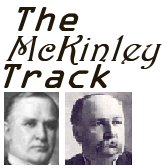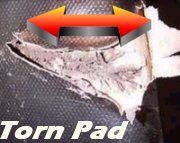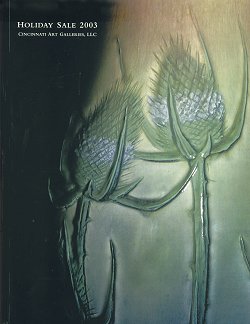Art Pottery, Politics and Food
Friday, November 07, 2003

Matt Drudge dishes up some of his patented Reagan movie distortions by joining in right wing efforts to disparage, of all people, former PFC and POW Jessica Lynch before her first public interview next week with the breathless headline, Lynch Rape Claim Challenged by Drs. Who Saved Her Life.
Reading the Drudge-written, and, most likely, White House flavored, story, we find our intrepid Matt countering the medical report in Rick Bragg's book with quotes from always truthful Iraqi doctors like Dr. Mahdi Khafazji:
She was injured at about 7 in the morning. What kind of animal would do it to a person suffering from multiple injuries?"
Some hope you might be wondering, “how could that book-deal-crazy Jessica say such mean things about the doctors who saved her” instead of wondering why this brave young woman is the focus of a coordinated right wing smear aimed at deflecting news from her upcoming set of interviews.
In Drudge’s second Iraqi quote, Dr. Jamal al-Saeidi confusingly indicated that he wasn’t looking for signs of sexual assault and that he didn’t see any:
When she was brought there she was fighting for her life. She was in shock because of the severity of her injury... Her clothes were not torn, buttons had not come off, her pants were zipped up."
I guess we are supposed to think no self respecting anal rapist would bother to rewrap the package???
Oh, tell us rape's proper etiquette, Matt!
If it is without USG assistance, our Drudge’s ability to ring up 3 appropriate Iraqi doctors and get English quotes all within one 24 hour news cycle is truly miraculous and someone should alert the Pope.
St. Matt concludes:
"Why are they saying such things?" the hospital's deputy director Dr. Khodheir al-Hazbar said. "We were good to her."
That Jessica!
I imagine we will hear some further elliptical ugliness from various mouthpieces during the weekend yak fests.
Photo: ABC
Hearty comforting nourishment is a welcome buffer to November's encroaching chill. This recipe, modified from one in a November 1999 issue of Gourmet, was my first encounter with a savory bread pudding.
As two or three slices from various loaves of bread always clutter my breadbox and freezer, this recipe, or any bread pudding for that matter, can resurrect these old bits into a great new comfort food glory.
.jpg)
If you want to dazzle at a holiday brunch, this dish, which puffs golden brown and smells heavenly, makes a fantastic presentation and tastes better than it looks.
Ham ‘n Swiss and Spinach Bread Pudding
Oven to 350
¾ pound of old Bread slices
½ stick of soft Butter
2 Onions, chopped
2 Tbsp Olive Oil
1 pound cooked Ham, chunked
4 large Eggs
2 cups heavy Cream
1 cup milk
1 Tsp Salt
1 Tsp ground Sage
1 pound baby leaf Spinach
¾ pound Swiss cheese, grated
Butter Bread slices and bake on cookie sheet in oven 1-15 minutes, or until golden. Cool.
Sauté Onions in Olive Oil until golden. Cool in bowl. Add butter to skillet and sauté Spinach eliminating as mush moisture as possible. Cool in bowl and add well-drained canned Spinach if amount not enough. Cook Ham chunks in skillet to brown slightly and eliminate moisture. Cool.
Spray an 11" X 14” X 2 ½“ baking dish with non stick spray.
Beat Eggs in a large bowl. Add Cream, Milk, Salt and Sage and beat to blend.
Cover bottom of baking dish with toasted Bread reserving Bread ends for top layer. Cover Bread slices with a generous layer of Ham, then layers of Spinach, Onion and Cheese. Cover with another layer of toasted Bread and repeat with Ham, Spinach, Onion and grated Swiss. Make a pattern with remaining slices of Bread and ends. Cover with remaining Ham, Spinach, Onion and Cheese.
Slowly ladle Egg and Cream mixture over combined Bread and Ham layers totally saturating top layer.
Bake for 45 to 60 minutes or until puffed, golden and appears firm.
I get many requests for this dish and recently made it with Bread ends from 5 different bakeries and specialty shops...wonderful!
Photo: Gourmet
Lynch'ed?
What prompted this past week’s black bag job on Senator Rockefeller’s office waste can, the contrived Confederate flag debate dust-up, the relentless Drudge-Reagan movie hysteria and the timing of Zell Miller’s confused endorsement of the current White House resident?
With their trademark Stalinist determination the last vestiges of ancient colonial imperialism and their toadies in the flawed marketplace are suddenly, now, generating great billowing clouds of obscuring smoke.
Why?

Slowly, I started to see a reason for the recent and extra loud right wing clamoring in the advance publicity for PFC Jessica Lynch’s first public interview next week.
Are the powerful men of the Bush administration afraid of one brave young woman from the hills of West Virginia and what she might say? Or, afraid of the conclusions some Americans might draw?
As if in answer to my thoughts, yesterday, the New York Daily News attempted a little negative spin toward PFC Lynch’s book:
Jessica Lynch…will open up big-time in November. The former prisoner of war, turned hero, talks with ABC News' Diane Sawyer on a "PrimeTime" special to be telecast Nov. 11 - Veterans Day - and then she'll appear with NBC News' Katie Couric, on Nov. 12. She'll also visit CBS' "Late Show" on Nov. 14 and CNN's "Larry King Live" on Nov. 17. Why? A book deal, of course. A day after Lynch appears on "PrimeTime" with Sawyer, Alfred A. Knopf will release "I Am a Soldier, Too: The Jessica Lynch Story," written by Rick Bragg.
Do you hear the faint echoes of the usually reliable money-hungry-publicity-hound attack strategy?
The Australian paper The Age doesn’t mince words with the seriousness of information to be presented next week:
The scars on Lynch's body and the medical records indicate she was anally raped, and "fill in the blanks of what Jessi lived through on the morning of March 23, 2003," [former NYT reporter and Lynch book author Rick] Bragg wrote.
This morning, a New York Times' quote from the ABC interview indicates Lynch’s reaction to the initial government reports about her capture:
It hurt in a way that people would make up stories that they had no truth about. Only I would have been able to know that, because the other four people on my vehicle aren't here to tell the story. So I would have been the only one able to say, yeah, I went down shooting. But I didn't.
Of her rescue:
I don't know why they filmed it, or why they say the things they, you know, all I know was that I was in that hospital hurting. I needed help.
I’m thinking the President will be giving his love-me-I’m-hurt face a serious workout next week.
Photo: Reuters
To the Moon, Alice!

Testimony of Dr. David R. Criswell, Director, Institute for Space Systems Operations, University of Houston, before the Senate Commerce, Science, and Transportation Subcommittee on Science, Technology, and Space Hearings: "Lunar Exploration"
Thursday, November 6, 2003, 2:30 PM – SR-253
By 2050…solar power from the Moon could provide everyone clean, affordable, and sustainable electric power…Solar power bases will…collect a small fraction of the Moon's dependable solar power…power beams…will…deliver lunar solar power to receivers on Earth. On Earth each power beam will be transformed into electricity and distributed…each power beam is restricted to 20%, or less, of the intensity of noontime sunlight…The Lunar Solar Power (LSP) System does not require basic new technological developments.
Photo: Reuters
Thursday, November 06, 2003
Wednesday, November 05, 2003

In the friendly atmosphere of the McKinley Administration, industrial combinations developed at an unprecedented pace...foreign policy, dominated McKinley's Administration.
Regarding Vice President Garret A. Hobart:
He was a corporate lawyer and exceptional fund raiser for the party and thus had no political experience before becoming vice president ...
He had a fear of public speaking and avoided public and senate orations.
He did rally support for the Spanish-American War effort, and was so adamant that we invade Cuba, McKinley used Hobart's pen to sign the declaration of war.
In early 1899 he started having fainting spells, then died of heart failure. William McKinley was deeply saddened by the loss of his close friend and advisor, but it did give the Republican party bosses an opportunity to muzzle New York’s governor by making him McKinley's running mate in 1900.
Photos: whitehouse.org and usatrivia.com

In a breakfast discussion with the Christian Science Monitor, posted on November 5th, teensy totalitarian Grover Norquist is still subtly lobbying for his radical Arab friends while his connection to the Army Chaplain spy ring arrests remains unnoticed by big media:
One soft underbelly in what I view as Republican dominance in the country is if we are seen as hostile to immigrants and immigration....
Yes, like fine young Saudi’s innocently seeking flight instruction, eh Grover?
Now while breakfasting reporters were stuffing eggs and sausage into unquestioning mouths, yesterday, and as Grover opined about his plans to dismantle Congress, his spat mate from the February CPAC fight, Frank Gaffney, on Monday continued to, oddly, be Grover’s right-wing media bete noir:
The trouble with Mr. Norquist's ties to the likes of al-Arian, Alamoudi and the SAFA Trust …is that they – and most of the other Arab- and Muslim-American organizations that Norquist and his institute have been closely associated with and assiduously helped to promote – are on the wrong side in the war on terror.
Gaffney had this Fox News post on October 24th:
Norquist has also reportedly used his ties to Karl Rove to assist pro-Islamist members of the Coalition to secure repeated access to White House and other senior Administration officials.
Photos: Thomas Butler, World Net Daily
Tuesday, November 04, 2003
What if, many long months and years ago, perhaps, even, as the old Soviet Union was collapsing, a small group of extremely wealthy radical Wahabi decided to buy up hundreds of suddenly unemployed economists, scientists and military specialists to develop a specific long-term plan to ham-string a giant on the ground in an expensively distant country?
These jeweled and enrobed effetes could safely assume their particular enemies within the Great Satan could be predictably Trojan horsed with cheap 3rd world labor.
Certainly, the Wahabi would think, no one could ever imagine these weak leaders resorting to their ultimate arsenal.
Two separate and disturbing news articles point toward the possible battlefield deployment of increasingly lethal tactics and, most disturbingly, an unknown weapon of tremendous potency.
In this Los Angeles Times story on portable missiles, I see no sense in a United States Army Brigadier General’s apparent conclusion that “the [Iraqi] resistance has become more sophisticated”.
Is it sophistication? Or, is it the gradual ratcheting of somebody’s plan?
Certainly the Hawala system is a clear proof that appearances can be deceiving and sophistication isn’t only reserved for technical elites
As the euphemisms for an escalating ground war proceed, so does the Bush Iraqification that gradually replaces US soldiers with quickly trained, reassuringly "background checked" and lower paid Iraqis.
Now, the shocking development that prompted my lead graph Wahabi reverie, in a November 2nd Army Times story reprinted, with photos, on the excellent Rense.com:

Shortly before dawn on Aug. 28, an M1A1 Abrams tank on routine patrol in Baghdad "was hit by something" that crippled the 69-ton behemoth.
Army officials still are puzzling over what that "something" was…According to an unclassified Army report; the mystery projectile punched through the vehicle's skirt and drilled a pencil-sized hole through the hull. The hole was so small that "my little finger will not go into it," the report’s author noted...

It seems clear that a penetrator of a yellow molten metal is what caused the damage…Whatever penetrated the tank created enough heat inside the hull to activate the vehicle's Halon firefighting gear, which probably prevented more serious injuries to the crew.
Photos: Rense.com
Monday, November 03, 2003

The highly selective and appraising eyes of dealers, collectors and scholars within the Art Pottery world were focused upon several 6th Street floors of the Cincinnati Art Galleries this past weekend for their annual Holiday Sale of American and European ceramics, Art Glass and, of course, Rookwood Pottery.
Gallery Director and PBS Antiques Roadshow appraiser, Riley Hummler, in a phone call this morning, said that while prices realized for Rookwood production were “down a little” contrasted against previous years, prices realized for higher quality were, generally, on a par with past sales.
My impression, having attended the last 5 of these, was that sales were strong but not robust.
Another personal impression, confirmed by gleanings from other attendees, was that most buyers felt they had gotten tremendous value for their dollar.
The auction room, on the 5th floor of the CAG’s east side 6th Street facility, was certainly as packed with eager buyers as previous auctions but the general mood seemed, after perhaps a brief exposure to the morning’s news, somewhat somber.
Glib and knowledgeable master auctioneer J. Louis Karp quickly brought the recalcitrant crowd to a semblance of happy purchasing excitement. But, even the ebullient Mr. Karp seemed a bit off his game when an internet snafu briefly interrupted the early moments of the auction and the calm placidity of CAG owners, Michele and Randy Sandler.
When we spoke, Karp, exhausted from a “massive” estate sale looming (including a never before heard of Sea Green glazed fireplace surround featuring relief carved fish), expressed surprised bafflement regarding the Internet.
Family-trained from childhood in fine arts and quality antiques, Karp instinctively hones in to the perceived discernment of a prospective buyer. The Internet, unfortunately to the occupants of a 3 dimensional space including Mr. Karp, seems more an aggressive unsophisticated impulse buyer and resistant to nonweb-based observation.
The CAG’s Internet coordinator told me that for each sale item there were a fluctuating total of around 45 people bidding through Ebay.
The 45 ever-changing Internet strangers, to our poor pre-digital Mr. Karp, and the other room attendees, rapidly mutated into one large cash-flush oaf.
I’m thinking the Ebay-Internet’s buying public, denied the tactility of a showroom perusal is more simpatico with a professional image of a sale item and CAG’s photographer Mark Mussio provided hundreds of sales-inducing images.
.jpg)
Attention-getting sale items included a superb 11” Iris Glaze vase decorated with Goldenrod by Rose Fletcheimer in 1903 sold, in spirited bidding, for $7,250. This was more than $3K over sale estimates.
.jpg)
An unusual and large porcelain by William Hentschel, with a drill hole obscuring some of its marks, hammered for $4,100 or $600 over estimate.
And, a 1902 Limoges-style vase stamped Rookwood and signed with the initials of Mary Louise McLaughlin sold, no doubt thanks to Anita’s Ellis’ new book on McLaughlin, well over its presale estimate high of $2K for $3,400.
The remaining clay pots, as it seemed to my observation, sold a touch below and within estimates.
The star of the weekend was the massive example of Rookwood’s rare and academically controversial Flowing Glaze line that graced the catalogue cover.
The striking vessel with its relief carved Teasel decoration hit this year’s high by hammering for $21,000, a figure lower than my recollection of previous records that sold in the mid $30 and $40K range.
According to the catalogue:
Flowing Glaze was briefly mentioned by Rookwood in 1902 and examples are listed twice in Burt (Stanley G., Rookwood’s chemist and superintendent) in 1901…all examples have been derivative of Iris glaze, i.e. a clear high glaze that seems to mingle (flow?) with the background colors…markings on this vase…the Rookwood logo and date, special shape number S1703 A, an incised W for White (Iris) glaze, an incised F, possibly for Flowing glaze and the incised full signature of the artist, Matt Daley. Also on the bottom is a serrated round label, which reads “Not For Sale”.
While a great deal is known about the Rookwood Pottery, Stanley G. Burt’s clay formulations and glaze experiments, transcribed by Karl Langenbeck, remain lost to history.
Since mixtures of 5 or more clays were required for most ceramic vessels (except Yellow clay for a brief time), the clays have proved less susceptible to scholarship than the glaze lines.
The most successful modern classification of Rookwood pottery has been Anita Ellis’ Rookwood: The Glaze Lines.
This modern classification has been a great help to collector’s and dealers alike.
Ellis and the CAG are to be complimented for their envelope-pushing scholarship!
Ellis, the Cincinnati Art Museum’s Director of Curatorial Affairs, was present at Sunday’s event and perhaps, also, noted the undescribed unique qualities of the clay under the above-mentioned Flowing Glaze.
I did notice her look of happy surprise when the example of McLaughlin’s Cincinnati Faience hit $1,400 over estimate!
Copies of the Holiday Sale 2003 can be purchased from the CAG.
Reference: The Book of Rookwood Pottery Vol. 1
Photos: from the Holiday '03 sale catalogue


